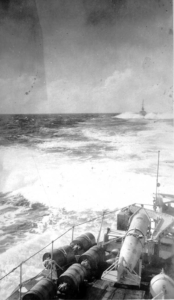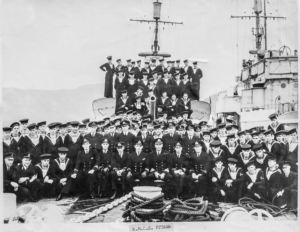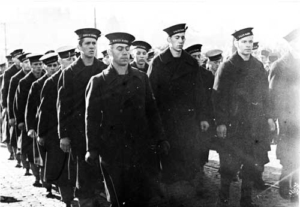OFFICIAL HISTORY OF
HMCS OTTAWA commissioned in the Royal Canadian Navy at Chatham, England, on 15 June 1938. Classified as a River class destroyer, she bore the name of one of Canada’s most historic and colourful rivers named for the proud Ottawa tribe of the Algonquins.
 With her sister ship, HMCS RESTIGOUCHE, OTTAWA was to be stationed on Canada’s west coast. But with the deterioration of international relations, climaxed by the conference at Munich, the destroyers were ordered to remain on the east coast until the situation had eased. The crisis passed and the following month both ships departed for their base at Esquimalt.
With her sister ship, HMCS RESTIGOUCHE, OTTAWA was to be stationed on Canada’s west coast. But with the deterioration of international relations, climaxed by the conference at Munich, the destroyers were ordered to remain on the east coast until the situation had eased. The crisis passed and the following month both ships departed for their base at Esquimalt.
OTTAWA and RESTIGOUCHE, formerly the Royal Navy destroyers CRUSADER and COMET, had been built at Portsmouth Dockyard and launched 30 September 1931. Their specifications were as follows:
- Displacement; 1,375 tons
- Complement: 145
- Dimensions: 317 ¾ (326 w.l.) X 33 X 8 ½ feet
- Guns: 4-4.7 inch; 7 smaller
- Tubes: 8-21 inch (quadrupled)
- Machinery: Parsons geared turbines
- S.H.P.: 36,000 – 36 knots
- Boilers: 3 Admiralty 3-drum type

Sister ships HMCS OTTAWA and HMCS RESTIGOUCHE in the Panama Canal. Photo Catalogue No. 2008.09.13 from the museum collection.
In May 1939, OTTAWA (Senior Officer), and the Western Destroyer Division – comprising HMC Ships OTTAWA, RESTIGOUCHE, ST. LAURENT and FRASER – escorted Their Majesties King George VI and Queen Elizabeth embarked in SS Princess Marguerite during their passage to Victoria from Vancouver and return. During their visit to Victoria, officers and men of the Destroyer Division participated in the solemn and colourful consecration, and presentation by His Majesty, of the King’s Colour to the RCN, on 30 May 1939.
In the late summer of 1939, world events moved to their grim, inexorable climax. On the 1st of September Canada’s navy was called to Active Service. HMC ships FRASER and ST. LAURENT had already departed for Halifax on 31 August 1939 to meet the growing German menace in the Atlantic. At 0001 on 15 November, OTTAWA and RESTIGOUCHE departed Esquimalt for Kingston, Jamaica, where it was planned to place the two destroyers at the disposal of the Commander-in-Chief, America and West Indies, for use against possible Nazi surface raiders in the Caribbean.
Upon arrival in Jamaica, on 29 November, it was decided that the RCN’s new flotilla leader, HMCS ASSINIBOINE – not yet equipped for winter conditions in the North Atlantic – should be used in the Caribbean, and OTTAWA and RESTIGOUCHE were consequently ordered to shape course for Halifax, where they arrived on 08 December. They were immediately assigned for service with the hard-pressed Halifax Escort Force.
Two days later, OTTAWA, in company with RESTIGOUCHE, FRASER and ST. LAURENT, led five British liners, carrying men of the First Canadian Division, out of the Halifax approaches. Some 500 miles out to sea, TC-1, first of the troop convoys to sail from Canada, was turned over to a powerful force of Royal Navy battleships for the passage to Britain.
In May 1940, in answer to an urgent Admiralty signal, four of the RCN’s destroyers – FRASER, ST. LAURENT, RESTIGOUCHE and SKEENA – hastened overseas as Britain braced for the heavily massed threat of German invasion. Throughout the tense days which followed, OTTAWA, SAGUENAY and ASSINIBOINE carried the onerous burden of convoy escort work in the Canadian North Atlantic.

HMCS OTTAWA on convoy escort duty during the Batlle of the Atlantic. Photo Catalogue No. VR991.397.30 from the museum collection.
With the tragic loss of FRASER while on duty off the coast of France, and the forthcoming return of RESTIGOUCHE for refit, OTTAWA was ordered to proceed overseas. She sailed from Halifax on 27 August.
OTTAWA made the crossing as ocean escort, with the British battleship HMS Revenge, for Troop Convoy 7, consisting of six large transports. Although German surface raiders had recently been active in the South Atlantic, and crafty U-boat aces continued to take their terrible toll of merchant shipping, the convoy reached its destination safely.
OTTAWA, allocated for escort duty in the North Western Approaches under Captain (D) Greenock, arrived in the Clyde on 04 September, 1940. These were the tense days when the eyes of the world watched anxiously as Britain’s Royal Air Force and the Luftwaffe clashed in mortal combat over Britain. Channel ports were closed and shipping routed northwards to the Mersey and the Clyde as Hurricane and Spitfire, Messerschmitt and Heinkel, trailed their deadly tracings across the autumn skies.
Based at Greenock, OTTAWA operated with the Royal Navy’s 12th Destroyer Flotilla. On 25 September, while Senior Officer of the escort with OB 217, outward bound from Britain, OTTAWA carried out an extensive hunt for U-boats, which had attacked the convoy and sunk several merchant ships. A wide search was unsuccessful in disclosing the whereabouts of the enemy. OTTAWA, however, was later able to recover some 115 survivors of the torpedoed merchantmen Eurymedon and Sulairia.
Two weeks later, OTTAWA formed part of the escort for WS-3, a troop convoy bound for the Middle East (the ‘WS’, according to Winston Churchill in his book Their Finest Hour, was an Admiralty term signifying ‘Winston’s Specials.”) The convoy was attacked on 08 October by a German bomber, and the troopship SS Oronsay suffered damage necessitating her return to port. The remainder of the convoy proceeded unharmed.
OTTAWA’s first dramatic encounter with the enemy occurred the following month. She had left the Clyde on 2 November with another troop convoy, WS-4, which she was to escort to a point off the southeast coast of Ireland. Here, her orders were to pick up a slow southbound convoy from Canada, SC-9. At 1945, on 04 November, as she was steaming towards her rendezvous position, an urgent signal was received from Commander-in-Chief Western Approaches (C.-in-C. W.A.) ordering OTTAWA, with HMS Harvester in company, to attack a U-boat shadowing Convoy OG-45 bound for Gibraltar from Britain. As OTTAWA, her entire company alerted for action, steamed in pursuit of the enemy, some 900 miles to the westward, the gallant Armed Merchant Cruiser Jervis Bay was making her heroic stand against the heavy guns of the German surface raider Admiral Scheer. (The time of that engagement was1700 to 2000, 5 November 1940).
At 1305, on 06 November, OTTAWA sighted the submarines on the surface, shelling the crippled merchantman Melrose Abbey. OTTAWA opened fire with her two forward guns while closing the U-boat at 34 knots. The submarine immediately dived. For more than 25 hours, OTTAWA and Harvester pursued the enemy. Nine attacks were carried out on promising contacts, but apart from a large oil slick which appeared during the morning of 07 November, no other traces of a possible kill were found. Both destroyers were credited with a joint kill by C.-in-C. W.A., but the more cautious Admiralty Assessment Committee in August 1943 reviewed his decision to “probably damaged.”
In the spring of 1951 OTTAWA, along with other Canadian destroyers in U.K. waters, was withdrawn to join the newly created Newfoundland Escort Force. From February 1941 onwards, German U-boats in the North Atlantic stretched their deadly tentacles ever westward.
The heyday of the surface raider was passing, but new-model U-boats, organized in wolf-packs, continued to prey on the thinly-escorted cargo ships. Winston Churchill in his memoirs Their Finest Hour confessed that:
“The only thing that ever really frightened me during the war was the U-boat peril.“
The answer lay in port-to-port anti-submarine escort for convoys, and this became a reality on the 1st of June 1941, when the Newfoundland Escort Force came into operation.
OTTAWA continued on duty with the Newfoundland Escort Force until her loss came some 15 months later. Battling the twin hazards of submarines and North Atlantic gales, the heavily worked escort vessels struggled relentlessly to overcome the fearful obstacles as they fought to get the precious cargo ships safely across the ocean.
September 1942 was a costly one for ships of the RCN. The armed yacht RACCOON, the corvette CHARLOTTETOWN, and the veteran destroyer OTTAWA all fell to the enemy within seven days. OTTAWA, at the time of her torpedoing, on the night of 13-14 September, formed part of the ocean escort for westbound convoy ON-127.
Over a period of five days, the convoy of 33 merchantmen suffered repeated attacks from two “wolf packs” totaling 13 U-boats. When the enemy, within range of aircraft from Newfoundland on 14 September, called off the attack, seven cargo ships and OTTAWA had been sent to the bottom.
At the time she was hit, OTTAWA, short of fuel, was about to be relieved by HMS Witch some 500 miles off St. John’s Newfoundland. The first torpedo struck the ship shortly after 2300 hours on 13 September, and OTTAWA’s Commanding Officer, Acting Lieutenant-Commander Clark A. Rutherford, RCN, signaled the Senior Officer in HMCS ST. CROIX:
“Have been torpedoed, no immediate danger of sinking.”
Ten minutes later, a second torpedo fatally crippled the ship. OTTAWA immediately began to break up and the order to abandon ship was given. Despite the fact that few of her ship’s company had been killed by the explosions, OTTAWA’s casualties were tragically high. 113 men, including five officers, perished in the icy water as they awaited for rescue. Among those who went down with the ship were her Commanding Officer; he had given his life jacket to a rating who was without one.



 CFB Esquimalt Naval and Military Museum
CFB Esquimalt Naval and Military Museum
 CFB Esquimalt Naval and Military Museum
CFB Esquimalt Naval and Military Museum CFB Esquimalt Naval and Military Museum
CFB Esquimalt Naval and Military Museum CFB Esquimalt Naval and Military Museum
CFB Esquimalt Naval and Military Museum CFB Esquimalt Naval and Military Museum
CFB Esquimalt Naval and Military Museum CFB Esquimalt Naval and Military Museum
CFB Esquimalt Naval and Military Museum CFB Esquimalt Naval and Military Museum
CFB Esquimalt Naval and Military Museum CFB Esquimalt Naval and Military Museum
CFB Esquimalt Naval and Military Museum CFB Esquimalt Naval and Military Museum
CFB Esquimalt Naval and Military Museum CFB Esquimalt Naval and Military Museum
CFB Esquimalt Naval and Military Museum CFB Esquimalt Naval and Military Museum
CFB Esquimalt Naval and Military Museum CFB Esquimalt Naval and Military Museum
CFB Esquimalt Naval and Military Museum
 CFB Esquimalt Naval and Military Museum
CFB Esquimalt Naval and Military Museum CFB Esquimalt Naval and Military Museum
CFB Esquimalt Naval and Military Museum CFB Esquimalt Naval and Military Museum
CFB Esquimalt Naval and Military Museum CFB Esquimalt Naval and Military Museum
CFB Esquimalt Naval and Military Museum CFB Esquimalt Naval and Military Museum
CFB Esquimalt Naval and Military Museum CFB Esquimalt Naval and Military Museum
CFB Esquimalt Naval and Military Museum CFB Esquimalt Naval and Military Museum
CFB Esquimalt Naval and Military Museum CFB Esquimalt Naval and Military Museum
CFB Esquimalt Naval and Military Museum CFB Esquimalt Naval and Military Museum
CFB Esquimalt Naval and Military Museum CFB Esquimalt Naval and Military Museum
CFB Esquimalt Naval and Military Museum

 CFB Esquimalt Naval and Military Museum
CFB Esquimalt Naval and Military Museum CFB Esquimalt Naval and Military Museum
CFB Esquimalt Naval and Military Museum CFB Esquimalt Naval and Military Museum
CFB Esquimalt Naval and Military Museum CFB Esquimalt Naval and Military Museum
CFB Esquimalt Naval and Military Museum CFB Esquimalt Naval and Military Museum
CFB Esquimalt Naval and Military Museum
 CFB Esquimalt Naval and Military Museum
CFB Esquimalt Naval and Military Museum



 CFB Esquimalt Naval and Military Museum
CFB Esquimalt Naval and Military Museum



































 CFB Esquimalt Naval and Military Museum
CFB Esquimalt Naval and Military Museum CFB Esquimalt Naval and Military Museum
CFB Esquimalt Naval and Military Museum
 CFB Esquimalt Naval and Military Museum
CFB Esquimalt Naval and Military Museum